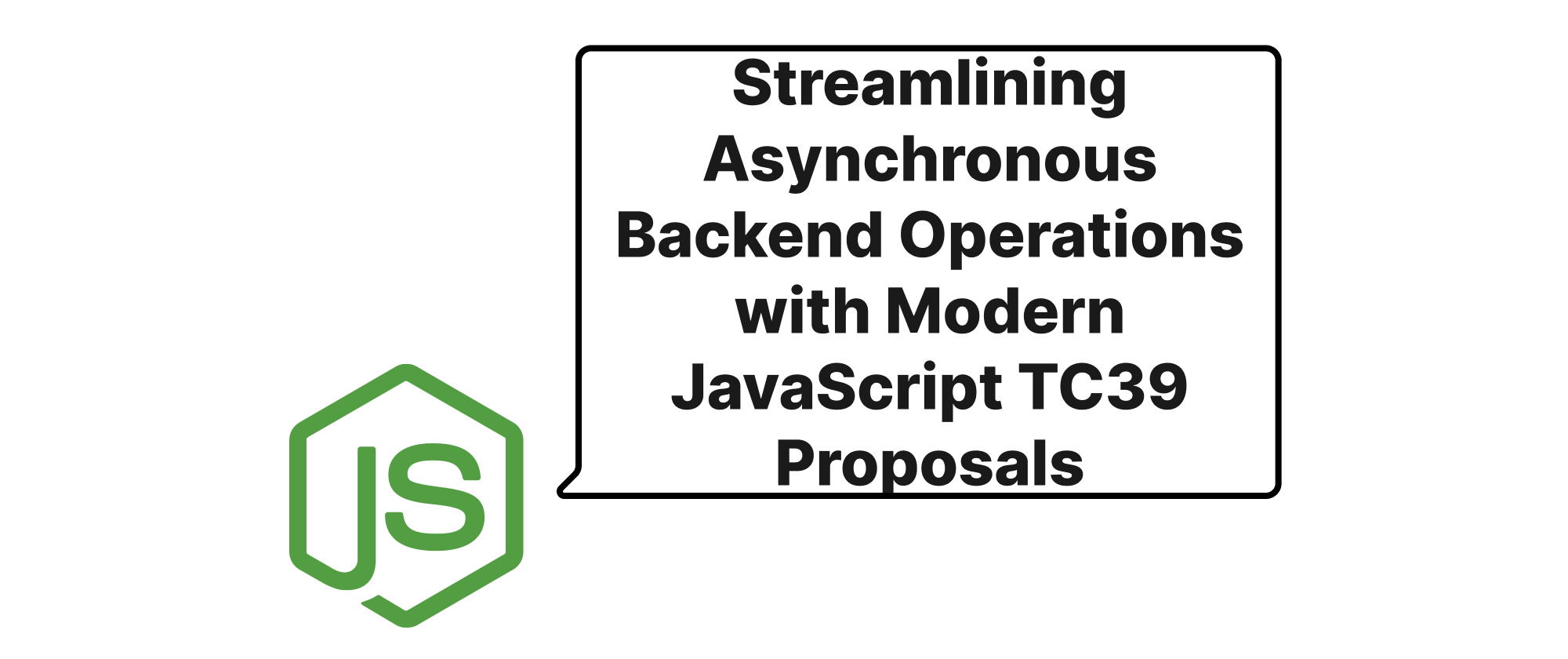Streamlining Asynchronous Backend Operations with Modern JavaScript TC39 Proposals
James Reed
Infrastructure Engineer · Leapcell

Introduction
As JavaScript solidifies its position as a ubiquitous language for backend development, particularly within the Node.js ecosystem, the effective management of asynchronous operations remains a cornerstone of building robust and scalable applications. Dealing with callbacks, promises, and async/await is second nature to most JavaScript developers. However, certain asynchronous patterns, especially those involving external event listeners or deferred promise resolution, can sometimes lead to boilerplate code or less-than-ideal readability. The ongoing evolution of JavaScript, driven by the TC39 committee, consistently strives to address such challenges by introducing new language features. Among the recent and exciting proposals, Promise.withResolvers emerges as a particularly promising contender for simplifying specific asynchronous flows, offering a more streamlined approach to creating and managing promises. This article will delve into how such modern TC39 proposals, with Promise.withResolvers as a prime example, can significantly simplify asynchronous code in backend services, making them more maintainable and easier to reason about.
The Foundations of Asynchronous JavaScript
Before we dive into the intricacies of Promise.withResolvers, let's quickly re-establish some fundamental concepts crucial for understanding its value.
- Promises: At their core, Promises are objects representing the eventual completion or failure of an asynchronous operation. They provide a cleaner alternative to callbacks for handling asynchronous results, enabling chaining (
.then(),.catch()) for sequential operations and error handling. A promise can be in one of three states: pending, fulfilled (resolved), or rejected. - Asynchronous Code Patterns:
- Call backs: Functions passed as arguments to be executed once an asynchronous operation completes. While fundamental, they can lead to "callback hell" with deeply nested structures.
- Async/Await: Syntactic sugar built on top of Promises, making asynchronous code look and behave more like synchronous code.
asyncfunctions always return a Promise, andawaitpauses the execution of anasyncfunction until a Promise settles, then unwraps its resolved value or throws its rejection reason.
- TC39 Proposals: The technical committee 39 (TC39) is responsible for standardizing ECMAScript (JavaScript). New features are introduced through a multi-stage proposal process, moving from "Stage 0: Strawperson" to "Stage 4: Finished" (ready for inclusion in the ECMAScript standard).
Promise.withResolversis one such proposal, currently at Stage 3.
Promise.withResolvers: A New Tool for Promise Management
Historically, creating a Promise where its resolve and reject functions need to be exposed outside its constructor's executor function has been cumbersome. Consider a scenario where you're integrating with an event-driven system or a legacy API that doesn't natively return Promises, but instead triggers a callback when an operation completes. You'd typically wrap this in a new Promise constructor:
// Traditional way to expose resolve/reject let resolver; let rejecter; const myDeferredPromise = new Promise((resolve, reject) => { resolver = resolve; rejecter = reject; }); // Later, perhaps in an event handler or another function: // resolver('Operation completed successfully!'); // rejecter(new Error('Operation failed!'));
While functional, this pattern requires declaring resolver and rejecter in an outer scope, which can feel clunky and less encapsulated. This is precisely the problem Promise.withResolvers aims to solve.
The Principle and Implementation
The Promise.withResolvers static method provides a cleaner, more idiomatic way to achieve the same deferred promise resolution. It returns an object containing three properties: promise, resolve, and reject.
// Using Promise.withResolvers (Stage 3 proposal) const { promise, resolve, reject } = Promise.withResolvers(); // 'promise' is the Promise that can be awaited or chained // 'resolve' is the function to fulfill the promise // 'reject' is the function to reject the promise // Example usage: setTimeout(() => { const success = Math.random() > 0.5; if (success) { resolve('Data loaded successfully!'); } else { reject(new Error('Failed to load data.')); } }, 1000); // In another part of your backend code: (async () => { try { const result = await promise; console.log('Async operation result:', result); } catch (error) { console.error('Async operation failed:', error.message); } })();
How it simplifies backend asynchronous code:
-
Cleaner Code for Event-Driven Architectures: Backend services often interact with message queues (e.g., RabbitMQ, Kafka), web sockets, or file system watchers, all of which are inherently event-driven.
Promise.withResolversallows you to easily "promisify" these events without nested boilerplate.// Scenario: Waiting for a specific message from a message queue // (Illustrative example with a hypothetical `mqClient` emitting 'message' events) function waitForMessage(topic) { const { promise, resolve, reject } = Promise.withResolvers(); const messageHandler = (msg) => { if (msg.topic === topic) { mqClient.off('message', messageHandler); // Clean up the listener resolve(msg.payload); } }; const errorHandler = (err) => { mqClient.off('error', errorHandler); mqClient.off('message', messageHandler); reject(err); }; mqClient.on('message', messageHandler); mqClient.on('error', errorHandler); // Optional: Add a timeout to prevent indefinite waiting setTimeout(() => { mqClient.off('message', messageHandler); mqClient.off('error', errorHandler); reject(new Error(`Timeout waiting for message on topic: ${topic}`)); }, 5000); return promise; } // Usage in an async backend route handler app.get('/api/message/:topic', async (req, res) => { try { const messageData = await waitForMessage(req.params.topic); res.json({ status: 'success', data: messageData }); } catch (error) { console.error(`Error waiting for message: ${error.message}`); res.status(500).json({ status: 'error', message: error.message }); } });This example clearly demonstrates how
Promise.withResolverscentralizes the promise control, making it straightforward to hookresolveandrejectinto external event handlers. -
Simplified Race Conditions and Timeouts: When dealing with multiple asynchronous operations and needing to resolve based on the first completion (or timeout),
Promise.withResolverscan simplify the setup. WhilePromise.raceis great, sometimes you need finer control over which async operation resolves a specific promise.// Example: Implementing a request-response pattern over a non-promise-based network library // Assume `networkClient` has a `send` method that takes a callback upon response receipt. function sendRequestWithCorrelationId(requestPayload) { const { promise, resolve, reject } = Promise.withResolvers(); const correlationId = generateUniqueId(); // A unique ID for this request const responseHandler = (response) => { if (response.correlationId === correlationId) { networkClient.off('response', responseHandler); // Clean up resolve(response.data); } }; const errorHandler = (err) => { networkClient.off('error', errorHandler); networkClient.off('response', responseHandler); reject(err); }; networkClient.on('response', responseHandler); networkClient.on('error', errorHandler); // Send the request, assuming `networkClient.send` would eventually cause a 'response' event networkClient.send({ ...requestPayload, correlationId }); // Optional: Timeout for the request setTimeout(() => { networkClient.off('response', responseHandler); networkClient.off('error', errorHandler); reject(new Error(`Request timed out for correlationId: ${correlationId}`)); }, 3000); // 3-second timeout return promise; } // Usage in a service layer: async function processUserData(userId) { try { const userData = await sendRequestWithCorrelationId({ type: 'fetchUser', id: userId }); console.log('User data received:', userData); return userData; } catch (error) { console.error('Failed to fetch user data:', error.message); throw error; // Re-throw for upstream error handling } } -
Integrating with Legacy APIs: Many older Node.js modules or external libraries might not return Promises directly.
Promise.withResolversoffers a clean bridge, allowing you to wrap callback-based APIs within a Promise interface, making them compatible withasync/await. This significantly reduces the cognitive load when mixing modern JavaScript with older codebases.
In essence, Promise.withResolvers provides direct access to the promise's internal control functions (resolve, reject) without the need for scope hoisting or awkward let declarations. This makes the intention of deferred resolution much clearer and leads to more concise and understandable code, particularly when dealing with truly external, non-promise-driven events or operations.
Conclusion
The Promise.withResolvers proposal represents a thoughtful enhancement to JavaScript's asynchronous capabilities, offering a cleaner and more direct API for scenarios requiring deferred promise resolution. By providing immediate access to the promise, resolve, and reject functions, it simplifies common patterns seen in backend development, such as integrating with event emitters, managing custom request-response cycles, and modernizing interactions with callback-based legacy code. As this proposal moves towards standardization, its adoption will undoubtedly lead to more readable, maintainable, and robust asynchronous code in Node.js applications, empowering developers to build complex backend systems with greater ease and clarity. This new primitive is set to become an invaluable tool for orchestrating intricate asynchronous flows in modern JavaScript backends.


